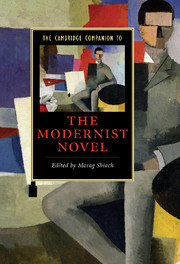Book contents
- Frontmatter
- Reading the modernist novel: an Introduction
- 1 Modernists on the art of fiction
- 2 Early modernism
- 3 Remembrance and tense past
- 4 Consciousness as a stream
- 5 The legacies of modernism
- KEY NOVELISTS
- 6 James Joyce and the languages of modernism
- 7 Tradition and revelation: moments of being in Virginia Woolf’s major novels
- 8 Wyndham Lewis and modernist satire
- 9 D. H. Lawrence: organicism and the modernist novel
- 10 Joseph Conrad’s half-written fictions
- 11 Djuna Barnes: melancholic modernism
- 12 William Faulkner: an impossibly comprehensive expressivity
- 13 Writing lives: Dorothy Richardson, May Sinclair, Gertrude Stein
- 14 C. L. R. James, Claude McKay, Nella Larsen, Jean Toomer the ‘black Atlantic’ and the modernist novel
- 15 Situating Samuel Beckett
- Further reading
- Index
14 - C. L. R. James, Claude McKay, Nella Larsen, Jean Toomer the ‘black Atlantic’ and the modernist novel
from KEY NOVELISTS
Published online by Cambridge University Press: 28 July 2007
- Frontmatter
- Reading the modernist novel: an Introduction
- 1 Modernists on the art of fiction
- 2 Early modernism
- 3 Remembrance and tense past
- 4 Consciousness as a stream
- 5 The legacies of modernism
- KEY NOVELISTS
- 6 James Joyce and the languages of modernism
- 7 Tradition and revelation: moments of being in Virginia Woolf’s major novels
- 8 Wyndham Lewis and modernist satire
- 9 D. H. Lawrence: organicism and the modernist novel
- 10 Joseph Conrad’s half-written fictions
- 11 Djuna Barnes: melancholic modernism
- 12 William Faulkner: an impossibly comprehensive expressivity
- 13 Writing lives: Dorothy Richardson, May Sinclair, Gertrude Stein
- 14 C. L. R. James, Claude McKay, Nella Larsen, Jean Toomer the ‘black Atlantic’ and the modernist novel
- 15 Situating Samuel Beckett
- Further reading
- Index
Summary
The posing went along famously. Soon the students began making polite conversation with me. They were all fierce moderns. Some of them asked if I had seen the African Negro sculptures … They seemed interested in what I had to say and talked a lot about primitive simplicity and color and 'significant form' from Cezanne to Picasso. Their naked savage was quickly getting on to civilized things.
Claude McKay, Banjo (1929)Modernism is often discussed in terms of movement: the increased speed brought about by new technologies and new modes of transport; the endlessly circulating networks of international capitalism; the global migrations of peoples. Anglo-American literary modernism, in particular, can be understood through transatlantic journeys, and the expatriate artistic communities created by these voyages. Yet despite this, modernist studies has continued to employ a nationally bounded methodology. This chapter’s focus on the 'black Atlantic' - African-American and Afro-Caribbean modernist writers and their literal and metaphorical transatlantic journeys - necessarily complicates the relationship between discrete nations and cultural production. In the epigraph to this chapter, taken from Jamaican Claude McKay’s Banjo (1929), West Indian Ray is working as a nude model in Paris. While the student artists signal their modernity through their knowledge of primitivism, their construction and objectification of the nonmodern, black body here does not allow for Ray’s entry into 'civilized' discourse.
- Type
- Chapter
- Information
- The Cambridge Companion to the Modernist Novel , pp. 206 - 223Publisher: Cambridge University PressPrint publication year: 2007
- 12
- Cited by

